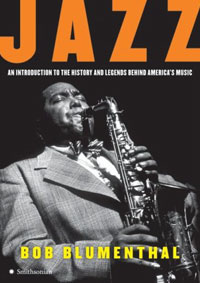Home » Jazz Articles » Interview » Bob Blumenthal: Jazz: An Introduction to the History and...
Bob Blumenthal: Jazz: An Introduction to the History and Legends Behind America's Music
The book is about as close to a multimedia presentation as one can achieve in print format.
 Jazz: An Introduction to the History and Legends Behind America's Music
Jazz: An Introduction to the History and Legends Behind America's Music Bob Blumenthal
Paperback; 192 pages
ISBN: 0061241792
HarperCollins
2007
Since 1969, when he first began writing about jazz, Bob Blumenthal has become not only a highly acclaimed writer but also one of the world's foremost authorities on jazz. He has contributed to numerous publications including Down Beat, The Boston Globe, Jazz Times, Rolling Stone and The Village Voice. He has also lent his expertise to such organizations as Jazz Alliance International, The Jazz Composers Alliance and the Recording Academy. As a commissioner for the Recording Industry Association of America, he helped select the White House Record Library during the Administration of President Jimmy Carter. He received the Jazz Journalists Association's "Excellence in Feature and Review Writing" award in 2001, as well as the JJA's "Lifetime Achievement" award in 2005. And, he won a Grammy for Best Album Notes in 1999, for John Coltrane's The Classic Quartet: Complete Impulse! Studio Recordings (Impulse!, 1998), and another in 2000, for The Complete Columbia Recordings: Miles Davis & John Coltrane (Columbia/Legacy, 200).
So, how should a writer with Bob Blumenthal's extraordinary qualifications go about introducing a novice to the subject of jazz? There isn't one universal meaning to the word, and there certainly is more than one sub-genre. Already, there is so much information available that trying to comprehend it all can seem daunting. In addition, not everyone wants to read a textbook on jazz. We are in the electronic age, and the Internet generation wants its information delivered in little bits and pieces, laced with interesting images.
In his first book, which is part of a Smithsonian paperback series, Blumenthal takes all of this into account and manages to hit his target audience dead center. The book is about as close to a multimedia presentation as one can achieve in print format. Its numerous images, along with Blumenthal's unpretentious and entertaining writing, entice the reader to see what's on the next page. The book also delivers a significant amount of information while presuming that the reader has little or no previous knowledge of the subject.
Blumenthal lays out the history of jazz chronologically, in chapters covering two decades each, making it easier to understand the music's development. Books that instead focus on individual styles can be confusing, because of the overlap of the time periods involved. Within each section, Blumenthal discusses the prevailing jazz styles and highlights the significant performers and innovators of that period, as well as other types of music that may have influenced that era. And he introduces the reader to up-and-comers of the time who would later make important contributions to jazz, as documented in subsequent chapters.
Once again recognizing his audience's preference for more than just text, Blumenthal places interesting tidbits of information in highlighted boxes throughout the book. And he ends each chapter with a representative list of songs from the given time period. This allows the reader to easily find and listen to each period's leading artists. After all, it's a book about music. You can't only read about music. You have to listen to it.
By contrast, an earlier book like John Szwed's Jazz 101 (Hyperion, 2000), which is perhaps more cerebral in its content, could be somewhat intimidating to the jazz novice, simply because of its textbook-like presentation. Although it is an excellent resource, Szwed's book assumes a basic understanding of jazz and perhaps should have been titled Jazz 201.
Blumenthal makes learning about jazz completely enjoyable. The book is entertaining and an easy read, the perfect introduction to jazz for the uninitiated—combining the information, images, and resources necessary to help the reader become more than a novice jazz enthusiast. But don't misunderstand, Blumenthal's own insights, gleaned from decades of involvement with jazz, should make the book appealing even to the veteran jazz fan.
A young jazz fan like this reviewer, talking to her friends about the theatric style of Cab Calloway, the humor of Louis Jordan, or even the passion that John Coltrane put into his music, can flip open the book, show them a photo and say, "Look, this guy right here!" The beauty is that these friends will quickly understand.
[A version of this article was first published in Jazz Notes, The Journal of the Jazz Journalists Association, Vol. 19, No. 1—Spring 2008.]
Tags
PREVIOUS / NEXT
Support All About Jazz
 All About Jazz has been a pillar of jazz since 1995, championing it as an art form and, more importantly, supporting the musicians who make it. Our enduring commitment has made "AAJ" one of the most culturally important websites of its kind, read by hundreds of thousands of fans, musicians and industry figures every month.
All About Jazz has been a pillar of jazz since 1995, championing it as an art form and, more importantly, supporting the musicians who make it. Our enduring commitment has made "AAJ" one of the most culturally important websites of its kind, read by hundreds of thousands of fans, musicians and industry figures every month.




















